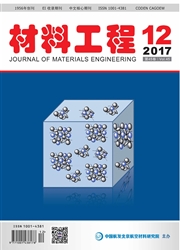

 中文摘要:
中文摘要:
通过对LZ50车轴钢表面进行渗氮/渗硫复合处理,在其表面形成渗氮/渗硫复合层。在对复合层进行表征的基础上,研究了复合层和基体在于态不同角位移幅值下的扭动微动磨损行为。结果表明:渗氮/渗硫复合层由ε—Fe3.3 N,γ'-Fe4N,FeS和FeS2相组成;复合层改变了LZ50钢的扭动微动运行区域,使得混合区减小,滑移区向小角位移方向移动;由于高硬度的渗氮层支撑和渗硫层润滑作用,复合层的摩擦扭矩在部分滑移区和滑移区低于LZ50钢;与LZ50钢相比,复合层的磨损程度明显降低,在部分滑移区损伤轻微,在混合区和滑移区,复合层的损伤主要表现为剥层,磨粒磨损和氧化磨损。
 英文摘要:
英文摘要:
The sulfurized-nitrided layers were prepared on the surface of LZ50 steel by sulfurized-nitri- ded duplex processes. Base on the characterizations of the sulfurized-nitrided layers, the torsional fret- ting wear tests of the sulfurized-nitrided layers and LZS0 steel were carried out in dry condition under different torsional angular displacement amplitudes. The results indicated the sulfurized-nitrided layers were composed of e-Fe2.3 N,γ'-Fe4 N, FeS and FeS2 phases. The fretting regimes of the sulfurized- nitrided layers were changed, i.e. the range of the mixed fretting regime was diminished, and the slip regime shifted to the direction of smaller angular displacement amplitude. The friction torques of the sulfurized-nitrided layers were lower than that of the substrate in the partial slip and slip regimes due to the support of the hard nitrided layer and the lubricating of the sulfide layer. Comparing with the substrate, the wear of material reduced greatly for the sulfurized-nitrided layers. The damage in the partial slip regime was slight, but in the mixed and slip regimes the damage mechanisms of the modified layer were mainly delamination, abrasive wear and oxidative wear.
 同期刊论文项目
同期刊论文项目
 同项目期刊论文
同项目期刊论文
 Tribological behavior of polymethyl methacrylate against different counter-bodies induced by torsion
Tribological behavior of polymethyl methacrylate against different counter-bodies induced by torsion Real time observation and friction vibration analysis of torsional fretting wear of polymethylmethac
Real time observation and friction vibration analysis of torsional fretting wear of polymethylmethac An experimental study on bending fretting fatigue characteristics of 316L austenitic stainless steel
An experimental study on bending fretting fatigue characteristics of 316L austenitic stainless steel Torsional wear behaviors of UHMWPE against Ti6Al4V alloy and alumina femoral head ball in dry condit
Torsional wear behaviors of UHMWPE against Ti6Al4V alloy and alumina femoral head ball in dry condit Comparison on the torsional fretting wear of nitrogen ion implanted pure titanium and Ti6Al7Nb alloy
Comparison on the torsional fretting wear of nitrogen ion implanted pure titanium and Ti6Al7Nb alloy The Torsional Fretting Wear Behavior of Nitrogen Ion Implantation Layer of Ti6Al7Nb Ally Under Bovin
The Torsional Fretting Wear Behavior of Nitrogen Ion Implantation Layer of Ti6Al7Nb Ally Under Bovin 期刊信息
期刊信息
